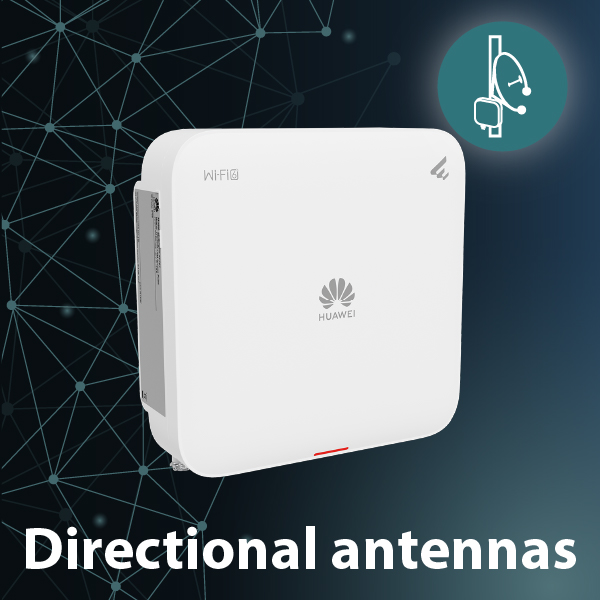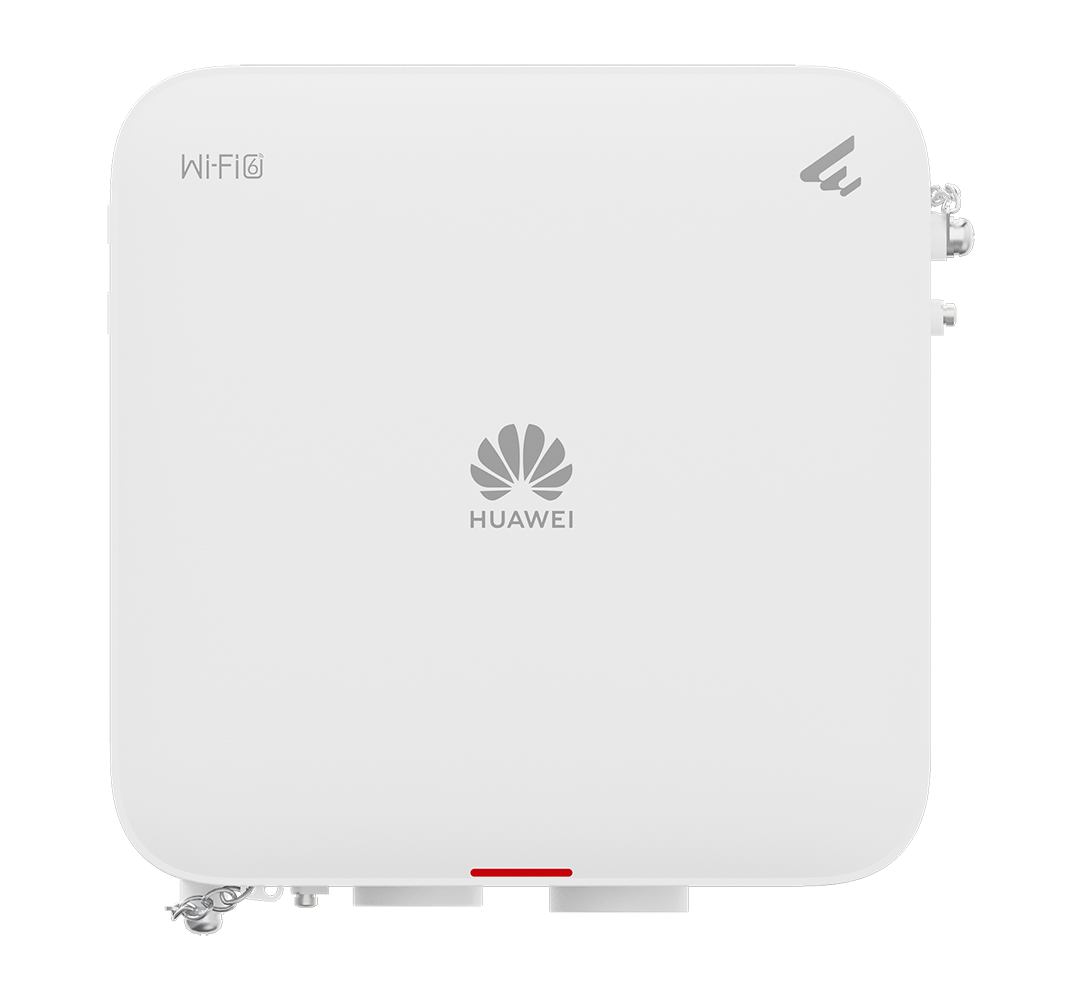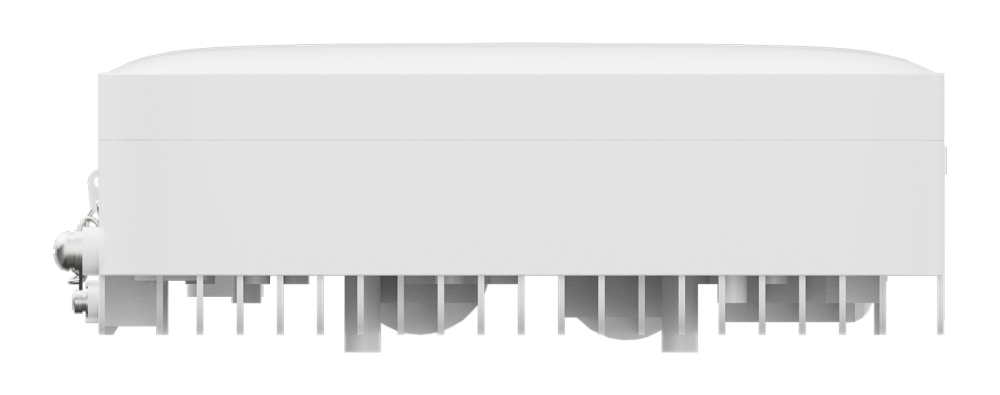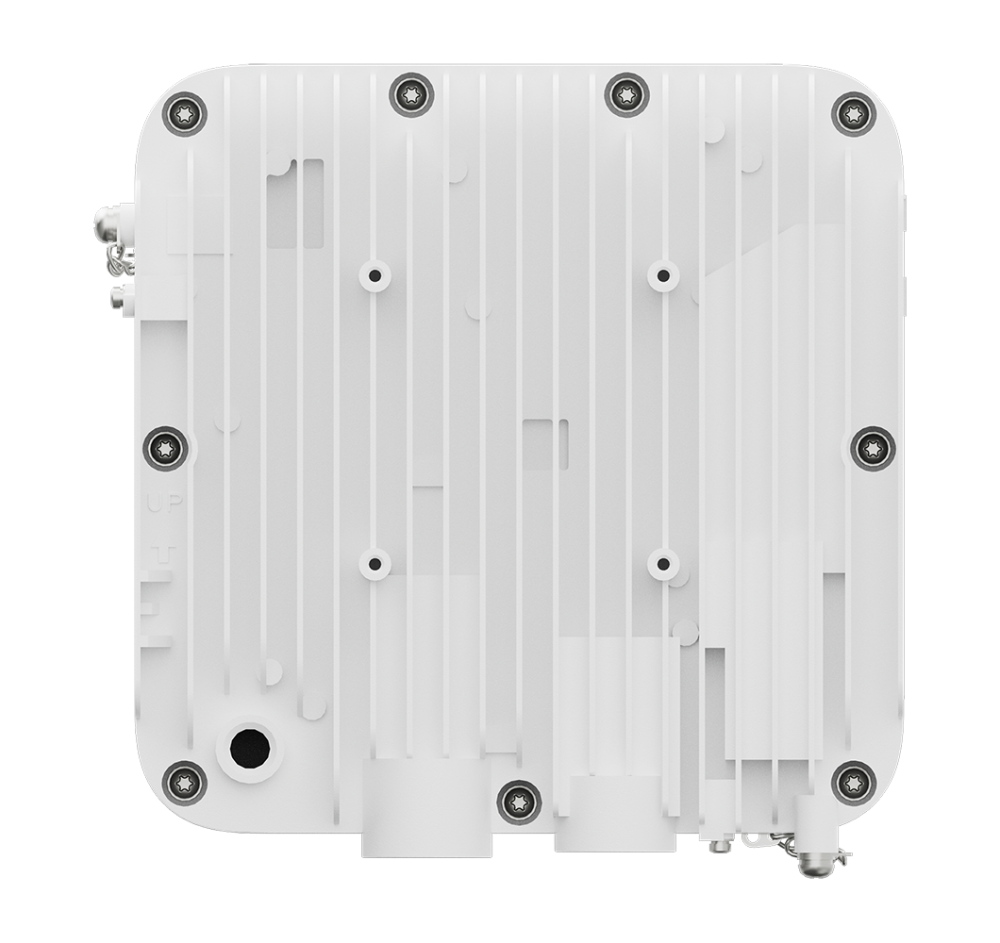The Huawei AP761 is an eKitEngine series access point supporting the Wi-Fi 6 standard. It operates with IEEE 802.11 b/g/n/ax protocols in the 2.4 GHz band and IEEE 802.11 a/n/ac/ax protocols in the 5 GHz band. Its maximum theoretical throughput is 574 Mb/s in the 2.4 GHz band and 1201 Mb/s in the 5 GHz band. The device supports MU-MIMO (simultaneous transmission and reception of data from multiple users), BSS coloring (transmission identification to reduce interference), and TWT (Target Wake Time - a feature that limits energy consumption). The access point has an outdoor-ready enclosure with an IP68 protection rating, suitable for wall or pole mounting. It features integrated directional antennas with a main beam width of 65° horizontally and 40° (2.4 GHz) / 20° (5 GHz) vertically, with a gain of 10 dBi in 2.4 GHz and 11 dBi in 5 GHz. These antennas provide excellent transmission coverage, capable of covering large wireless network areas. The device includes 1 gigabit Ethernet port (10/100/1000 Mb/s) and 1 SFP slot. Power can only be supplied using PoE in the 802.3af/at standard; the manufacturer suggests using the 802.3at standard (some features are limited with 802.3af).
The offered product can operate in several modes: Fat AP, Fit AP, or Cloud. In Fat AP mode, the device functions independently, allowing you to configure it as a regular wireless router. Cloud mode enables connecting the device to a controller located in the cloud, while Fit AP mode is used to connect to another physical WLAN AC controller. Solutions from the eKitEngine series enable you to create an extensive and efficient wireless network that can cover very large areas. The devices support data roaming, bandwidth control, and various authentication methods. The AP761 is suitable for many networks requiring outdoor coverage, such as restaurants, pools, or parks.
Wi-Fi 6 AX1800 wireless network, Bluetooth
The AP761 is designed to transmit Wi-Fi 6 wireless networks, supporting IEEE 802.11 b/g/n/ax protocols in the 2.4 GHz band and IEEE 802.11 a/n/ac/ax protocols in the 5 GHz band. Its maximum theoretical throughput is 574 Mb/s in the 2.4 GHz band and 1201 Mb/s in the 5 GHz band. This speed is more than sufficient for most internet activities, including streaming 4K videos online, gaming, or downloading large files.
The access point also utilizes several additional features that positively impact network quality. MU-MIMO allows simultaneous transmission and reception of data from multiple clients, eliminating data queuing. Beamforming shapes the beam to improve connection with devices at the edge of the coverage area, while TWT (Target Wake Time) conserves energy by waking connected devices only when a transmission is initiated.
Additionally, the device supports Bluetooth transmission (BLE 5.2), which you can utilize for remote management, localization, or IoT applications, among others.


Gigabit Ethernet port, SFP slot, Power over Ethernet
The offered product is equipped with 1 gigabit Ethernet port (10/100/1000 Mb/s) and 1 SFP slot. The Ethernet port serves as the input for IEEE 802.3 af/at PoE power - this is the only method of power supply. The manufacturer suggests using 802.3at; with 802.3af, some functions may be limited. The maximum power consumption is 17.7 W.
The SFP slot allows for transmission using a fiber optic cable. This is particularly important if you're using the AP761 in a location distant from the rest of the network segments or in a network where devices are dispersed.
Directional antennas
The access point features directional antennas. In the 2.4 GHz band, the gain is 10 dBi, with a main beam width of 65° horizontally and 40° vertically. In the 5 GHz band, the gain is 11 dBi, with a main beam width of 65° horizontally and 20° vertically. Thanks to the use of these antennas, the AP761 stands out from the competition with excellent coverage. It is capable of covering a much larger area with Wi-Fi signal compared to devices using omnidirectional antennas. This is particularly important in open spaces, for which it is designed.


Waterproof enclosure
The device is fully designed for outdoor use. Its enclosure protects the interior from moisture and dust ingress, with an IP68 protection rating. The access point is adapted for wall or pole mounting. An additional advantage is the 6 kA surge protection, essential for using the device outdoors.
Up to 1024 clients
The Huawei AP761 can support a maximum of 1024 clients (512 per radio) connected simultaneously. It performs excellently in locations where there may potentially be many users. The system supports load balancing and smart roaming, ensuring that if one access point becomes overloaded, users are switched to others.
The DFA (Dynamic Frequency Allocation) algorithm is used for automatically detecting wireless channel usage and identifying overlapping transmissions. In the case of multiple access points, they operate in a way to avoid interfering with each other. Additionally, technologies such as EDCA (Enhanced Distributed Channel Access) and airtime scheduling allow for planning the schedule of channel utilization by specific client devices, ensuring equal access to the network for each of them.
A significant advantage of the system based on eKitEngine APs is the optimization of network utilization by client devices. Clients with low signal strength or low connection speed are automatically disconnected to improve overall transmission quality. Additionally, the AP761 features a 5G-prior function - client devices are primarily connected in the 5 GHz band to provide them with the best possible throughput. This significantly reduces the load and interference in the 2.4 GHz band.


Advanced wireless system
The offered product is designed to work in a large wireless system composed of multiple access points. Such a network is capable of covering even very large areas, depending on the number of devices used. The system supports data roaming, where users are automatically switched between individual access points without losing their connection.
Huawei solutions offer a wide range of features related to bandwidth control, improving transmission quality, and security. For user authentication, you can utilize methods such as 802.1x, MAC addresses, or captive portals. An advanced management and monitoring system will help you reduce the time spent on network administration, for example, through automatic detection and recognition of various types of errors.
Four operating modes
Access points can operate in four modes:
- Fat AP - the access point operates independently, and configuring and managing it resembles the process for standard wireless routers. It's suitable for small networks where you use only one AP.
- Leader AP - It allows configuring the device as a "leader," thereby taking on the role of a controller in the network. You can connect other access points to the device in Leader AP mode to create an expanded system. This mode is best suited for small networks, such as offices or restaurants, and helps reduce costs associated with purchasing additional controllers.
- Cloud AP - in this mode, the access point can be managed from a cloud-based platform. This platform significantly simplifies monitoring and conducting initial configurations, eliminating the need for additional management devices.
- Fit AP - this is the basic mode of operation in which the access point connects to a controller.


Multiple uses
The Huawei AP761 finds its application in many networks where there is a need to distribute the signal outdoors. These include hotels, restaurants, pools, or parks. Thanks to its directional antennas, it provides excellent coverage, capable of reaching a large area. Its durable, waterproof enclosure also makes the AP761 suitable for indoor use, especially in demanding locations. You can successfully deploy it in various types of production halls or warehouses where the access point is exposed to dust.








Comments
There are no comments yet.. Add your first comment